Harini K1 and Radhika Arjunkumar1
1Saveetha Dental College,Saveetha Institute of Medical and Technical Sciences, Saveetha University Chennai, India.
2Department of Periodontics,Saveetha Dental College, Saveetha Institute of Medical and Technical Sciences, Saveetha University Chennai, India.
Corresponding Author E-mail: radhikaarjunkumar@gmail.com
DOI : https://dx.doi.org/10.13005/bpj/1530
Abstract
Diode laser are used for soft tissue surgeries in the oral cavity.The use of laser is limited due to the lack of knowledge, effectiveness and the high cost of laser unit. The use of lasers can decrease morbidity after surgery and reduces the need for anaesthetics.the laser is used for caries prevention, bleaching, restorative removal and curing, cavity preparation, dentinal hypersensitivity, growth modulation and for diagnostic purposes, whereas soft tissue application includes incision, excision, ablation, wound healing, removal of hyperplastic tissue to uncovering of impacted or partially erupted tooth, photodynamic therapy for malignancies, photo stimulation of herpetic lesion. Although dental lasers was introduced in 1964, its knowledge and implementation has increased only in past 15-20 years especially in developing countries like India. In order to evaluate the knowledge on laser and its implementationin the field of dentistry among dentists in Tanjore, this survey was conducted among dentists in Tanjore. This cross-sectional, descriptive study was carried out among dentists in Tanjore. A questionnaire consisting of 3 main parts was designed and administered to dentists in Tanjore and knowledge was assessed. The data were entered and analysed statistically. 14% of dentists have adequate knowledge,46% of dentists have moderate knowledge, 39% of dentists have inadequate knowledge.35% of dentists had practiced laser dentistry before.The wellknown information among dentists about the dental laser is the lasers application in gingivectomy and crown lengthening. 50% of dentists felt that cost of laser unit is the biggest deterrant in practicing laser dentistry. Most of the dentists have only moderate knowledge on laser.Education should be given on laser to increase its implementation in field of dentistry.
Keywords
Dentists; Dental Laser; Ducation; Knowledge; Tanjore
Download this article as:| Copy the following to cite this article: Harini K, Arjunkumar R. Awareness of Laser Dentistry Among Dentists in Tanjore- A survey. Biomed Pharmacol J 2018;11(3). |
| Copy the following to cite this URL: Harini K, Arjunkumar R. Awareness of Laser Dentistry Among Dentists in Tanjore- A survey. Biomed Pharmacol J 2018;11(3). Available from: http://biomedpharmajournal.org/?p=21504 |
Introduction
In the present era, Clinicians are keenly searching for better techniques, instruments and materials that allow the delivery of superior dental treatment with better patient comfort. Technologies like CAD-CAM restorations, digitalradiography and photography, implantology, maxillofacial dentistry, etc are gaining tremendous amount of popularity by providing an efficient and beneficial alternative over the conventional dentistry. The use of lasers is one of these hallmark technologies that enables dentist to work faster, more precisely and more efficiently.1 Laser is an acronym for Light Amplification by Stimulated Emission of Radiation. Lasers work on the principle of stimulated emission theory proposed by Albert Einstein in 1917 based on the concept of spontaneous stimulated emission theory which was postulated by Neil Bohr in early 1900s.2 Traditionally, lasers have been classified according to the physical construction of laser. (eg: gas, liquid, solid state or semiconductor diode), the type of medium which undergoes lasing ( eg: Erbium: Yttrium Aluminium Garnet) (Er: YAG) and the degree of hazard to the Skin or eyes.3 In hard tissue application, the laser is used for caries prevention, bleaching, restorative removal and curing, cavity preparation, dentinal hypersensitivity, growth modulation and for diagnostic purposes, In soft tissue application,laser is used for incision, excision, ablation, wound healing, removal of hyperplastic tissue to uncovering of impacted or partially erupted tooth, photodynamic therapy for malignancies, photo stimulation of herpetic lesion. Use of the laser proved to be an effective tool to increase efficiency, specificity, ease, and cost and comfort of the dental treatment. 4 Besides itsbenefits, laser has its own disadvantages such as relatively high cost of laser unit,specialised training and education on operations of laser, different lasers for different procedures,inability of erbium family of lasers to remove metallic and cast-porcelain defective restorations, disease transmission in immunocompromised patients by laser generated aerosols, harmful to eyes.2
The aim of this study was to create awareness of laser among dentists inTanjore, one of the cities of Tamil Nadu with the population of over 24 lakhs. There are about 60 dental clinics in Tanjorewhere more than 70 dentists are practicing. In view of the increasing availability of new technologies in dental practices, the need for more education and training this survey was conducted to assess the education level and knowledge about laser in dentistry among dentists in Tanjore.
Materials and methods
This cross-sectional, descriptive study was carried out among dentists in Tanjore.A questionnaire consisting of 3 main parts was designed and administered to dentists in Tanjore. The first part of questionnaire consists of 7 items regarding the dentist’s dental laser education and training. The second part consisted of 34 items in 6 sections. Each section contained items related to use of laser in 5 different dental specialities. [oral surgery (8 items), Endodontics (4 items), Periodontics (4 items), Operative dentistry (10 items), Pediatric dentistry/orthodontics (4 items), in addition to sometimes in laser production (4 items). The Third part contained of 19 items in 5 sections. [Advantage of laser, effect of laser on dental tissues, expenditure of laser treatment, biggest deterrant in practicing laser dentistry, types of laser to have in practice]. The data were entered and analyzed statistically.Each correct answer was given score and these scores were taken to analyze their knowledge.The score between 1-14 were considered as the inadequate knowledge, 15-28 were considered ad the moderate knowledge, 29-42 were considered as the adequate knowledge.
Results
This questionnaire was given to 70 dentists in Tanjorefrom which 28 dentists(17 male, 11 female dentists)came out with positive responses. The negative responses are mainly due to their busy schedule and unwillingness to participate in the study.96% of dentists were aware that lasers were used in dental practice. Only 35% of dentists had practiced laser dentistry before. Most of the dentists had interest in dental laser. Table 1 also shows that their dental laser knowledge obtained mainly in Periodontics, Oral surgery and Endodontics. The most known laser types among them were Nd: YAG, diode lasers.Regarding dentist’s laser knowledge, Table 2, chart 2 shows the dentists responses of each item in each section and mean score of each section. The best score was obtained in oral surgery followed by periodontics and endodontics sections(10.87,10.75,10.5) respectively. The lowest was recordedin laser protectionfollowed by operative dentistry, pediatric dentistry(8.75,8.9,9.25) respectively. The scores of all students for each itemis presented in chart 1. The wellknown information among dentists about the dental laser is the lasers application in gingivectomy and crown lengthening.
Table 1: Dentist response about laser education and their practice
| Items | Number of Respondents | Percentage |
| Male | 17 | 60.7 |
| Female | 11 | 39.3 |
| Aware that lasers are used in dental practice | 27 | 96.4 |
| Practiced laser dentistry ever before | 10 | 35.7 |
| Had interest in dental laser | 24 | 85.7 |
| Hours of dental laser education | ||
| 0 hr | 13 | 46.4 |
| 1 -3 hr | 11 | 39.2 |
| >4 hr | 4 | 14.4 |
| Laser education in dental courses | ||
| Endodontics | 18 | 64.3 |
| Oral surgery | 25 | 89.2 |
| Pediatric dentistry/orthodontics | 15 | 53.5 |
| Periodontics | 19 | 67.8 |
| Operative dentistry | 13 | 46.4 |
| Others | 4 | 14.2 |
| Known laser type | ||
| Co2 | 8 | 28.5 |
| Er:Cr:YSGG | 6 | 21.4 |
| Diode | 15 | 53.5 |
| Er:YAG | 10 | 35.7 |
| Nd:YAG | 16 | 57.1 |
| Argon | 11 | 39.2 |
| None | 1 | 3.5 |
Regarding dentist’s laser knowledge, Table 2, chart 2 shows the dentists responses of each item in each section and mean score of each section. The best score was obtained in oral surgery followed by periodontics and endodontics sections(10.87,10.75,10.5) respectively. The lowest was recordedin laser protectionfollowed by operative dentistry,pediatric dentistry(8.75,8.9,9.25) respectively. The scores of all students for each itemis presented in chart 1. The wellknown information among dentists about the dental laser is the lasers application in gingivectomy and crown lengthening.
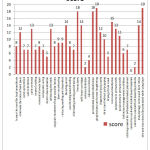 |
Graph 1: Score of each item |
 |
Graph 2: Mean score of each section |
Table 2: Dentist response about the dental laser uses
| Laser can be used for /to | No of correct response (%) | No of incorrect response(%) | score | Section mean score (SD) |
| In Operative dentistry | ||||
| Lessen the need for local anesthesia | 8 (28.5) | 20 (71.5) | 8 | 8.9 |
| Eliminate the noise of the hand piece | 12 (42.8) | 16 (57.2) | 14 | |
| Caries prevention | 7 (25) | 21 (75) | 7 | |
| Caries detection | 7 (25) | 21 (75) | 7 | |
| Caries removal | 13 (46.5) | 15 (53.5) | 13 | |
| Enamel etching | 7 (25) | 21 (75) | 7 | |
| Removal of smear layer | 8 (28.5) | 20 (71.5) | 8 | |
| Composite curing | 7 (25) | 21 (75) | 7 | |
| Dentin desensitization | 5 (17.8) | 23 (82.2) | 5 | |
| Whitening the teeth | 13 (46.5) | 15 (53.5) | 13 | |
| In Oral surgery | ||||
| Surgical treatment of large vascular lesions | 8 (28.5) | 20 (71.5) | 8 | 10.87 |
| Bone raecontouring | 9 (32.14) | 19 (67.86) | 9 | |
| Reducing swelling and discomfort | 9 (32.14) | 19 (67.86) | 9 | |
| Bleeding arrest | 14 (50) | 14 (50) | 14 | |
| Accelerating wound healing | 8 (28.5) | 20 (71.5) | 8 | |
| Eliminating suturing and dressing | 7 (25) | 21 (75) | 7 | |
| Frenectomy | 18 (64.28) | 10 (35.72) | 18 | |
| Soft tissue curettage | 14 (50) | 14 (50) | 14 | |
| In Periodontics | ||||
| Calculus detection | 2 (7.14) | 26 (92.86) | 2 | 10.75 |
| Calculus removal | 4 (14.28) | 24 (85.72) | 4 | |
| Periodontal pocket disinfection | 18 (64.29) | 10 (35.71) | 18 | |
| Gingivectomy and crown lengthening | 19 (67.85) | 9 (32.15) | 19 | |
| In Endodontics | ||||
| Diagnosis of pulp vitality | 12 (42.85) | 16 (57.15) | 12 | 10.5 |
| Direct and indirect pulp capping | 10 (35.71) | 18 (64.29) | 10 | |
| Drying of the root canal | 5 (17.8) | 23 (82.2) | 5 | |
| Root canal disinfection | 15 (53.58) | 13 (46.42) | 15 | |
| In pediatric dentistry | ||||
| Pulpotomy in primary teeth | 13 (46.5) | 15 (53.5) | 13 | 9.25 |
| Pulpectomy in primary teeth | 11 (39.28) | 17 (60.72) | 11 | |
| Behaviour management in children | 6 (21.42) | 22 (78.58) | 6 | |
| Etching enamel for orthodontics bracket placement | 7 (25) | 21 (75) | 7 | |
| In Laser protection | ||||
| Cannot be used with alcohol based materials | 0 | 28 (100) | 0 | 8.75 |
Table 3: Dentists response about their dental laser knowledge
| Laser can be used for /to | No of correct response (%) | No of incorrect response(%) | score | Section mean score (SD) |
| Advantage of laser | ||||
| Less pain | 20 (71.42) | 8 (28.58) | 20 | 8.75 |
| Less bleeding | 22 (78.57) | 6 (21.43) | 22 | |
| Less time taken | 20 (71.42) | 8 (28.58) | 20 | |
| Lesser need for local anesthesia | 18 (64.28) | 10 (35.72) | 18 | |
| All the above | 16 (57.14) | 12 (42.86) | 16 | |
| Effect of laser on dental tissues | ||||
| Hemostasis | 20 (71.42) | 8 (28.58) | 20 | 19 |
| Ablation | 18 (64.28) | 10 (35.72) | 18 | |
| Decontamination | 18 (64.28) | 10 (35.72) | 18 | |
| All the above | 13 (46.42) | 15 (53.58) | 13 | |
| None of the above | 2 (7.14) | 26 (92.86) | 26 | |
| Dental laser treatment expensive | 20 (71.42) | 8 (28.58) | 20 | 20 |
| Biggest deterrant in practicing dentistry | ||||
| Cost of laser unit | 14 (50) | 14 (50) | 14 | 14.25 |
| Lack of knowledge among the dentists about laser dentistry | 8 (28.58) | 20 (71.42) | 8 | |
| Difficulty in convincing the patient / recovering the costs in your practice | 9 (32.14) | 19 (67.86) | 9 | |
| None | 2 (7.14) | 26 (92.86) | 26 | |
| Types of laser like to have in practice | ||||
| Er:Cr:YSRR | 3 (10.72) | 25 (89.28) | 13 |
14.75 |
| DIODE | 16 (57.14) | 12 (42.86) | 16 | |
| Er:YAG | 6 (21.42) | 22 (78.58) | 6 | |
| None | 4 (14.28) | 24 (85.72) | 24 | |
Discussion
Education at dental college is the most important source for dentists as they depend on the information provided in college. This study provides a general view about dental laser education and knowledge among dentists. This survey only assessed some basic knowledge of dentists regarding uses, advantages, effects of laser.
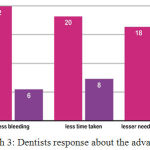 |
Graph 3: Dentists response about the advantage of laser |
Many dentists reported that they had laser education in oral surgery followed by periodontics, endodontics. Similarly, high mean score on advantage of laser in each section was obtained on oral surgery followed by periodontics, endodontics. Hence this shows that more the education the dentists had, the more knowledge they gained about laser. This also shows that dentists mainly depend on their college for gaining knowledge related to the subject.5
Majority of dentists, reported that they did not receive dental laser education during their college study programs. Only few dentists had practiced laser dentistry but majority of dentists had interest in practicing laser.
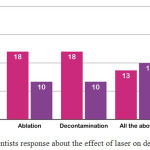 |
Graph 4: Dentists response about the effect of laser on dental tissues.
|
Most of the information about dental laser was provided in Periodontics, Oral Surgery, Endodontics due to the implementation of laser in calculus detection, soft tissue surgery, canal disinfection, drying of pulp cavity.6,7 Some information was given in pediatric dentistry/ortho & operative dentistry.
Laser systems existing in dentistry can be transferred in dental canals via fiber optics like Nd:YAG Argon and Diode lasers or by hollow tubes such as CO2 Er:YAG lasers, and by doing so benefit from biomechanical intra canal cleaning as well as bactericidal ability of laser radiation will be achieved. Nd:YAG was one of the first lasers to be used for canal disinfection.8,9,10,11,12 Er:YAG laser has been considered the most promising for periodontal therapy mainly due to its property to ablate soft and hard tissue without major thermal side effects. There is extensive evidence in literature to prove the comparable calculus removal effect of Er:YAG lasers (Keylaser 1 or 2; Kavo, Biberach, Germany) to conventional root debridement. Keylaser 3 (Kavo, Biberach, Germany) is the only commercially available device, which combines calculus detection and removal in a feedback-controlled manner. The automated device contains a 655-nm InGaAs diode laser for calculus detection and a 2940-nm Er:YAG laser for calculus removal.13
 |
Graph 5: Dentists response about biggest deterrent in practicing laser dentistry
|
Many applications of laser in dentistry were not familiar to dentists as these applications are recently reported in the literature and proved its efficiency. Majority of dentists did not know about the uses of laser in operative dentistry like dentin desensitization. According to a systematic review which was done by Sgolastra et al laser therapy can reduce dentin hypersensitivity related pain, but the evidence for its effectiveness is weak, and the possibility of a placebo effect must be considered. A systematic review on the effectiveness of laser therapy in treating dentine hypersensitivity reported that laser therapy has a slight clinical advantage over topical medicaments in the treatment of dentine hypersensitivity.14,15
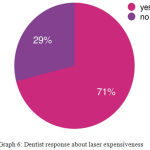 |
Graph 6: Dentist response about laser expensiveness
|
In addition, most of them were not familiar with its applications in pediatric dentistry such as behaviour management in children and etching enamel for orthodontics bracket placement. LF at a wavelength of 655 nm (nonablative with red light) can be used as an adjunct for disclosing occlusal caries in primary and permanent teeth and due to its high reliability, predictability and reproducibility, it decreases diagnostic errors.16,17 Lasers can provide treatment without the need for needles and high-speed hand pieces causing less intra and post-operative discomfort to the children. Furthermore, there is less need for behavioural management therapies in case of lasers assisted therapy.18 Laser etching is a successful etching alternative to acid etching. Laser etching provides a successful debonding of the brackets from the enamel surface without causing fractures.19
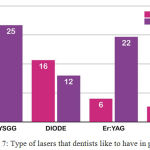 |
Graph 7: Type of lasers that dentists like to have in practice
|
In laser protection, 67% of people are aware that skin and eyes should be protected while using laser. The eye damage caused by the laser includes retinal lesion, retinal burn, Cataract, aqueous flare, corneal burn. The skin damage caused by the laser includes excessive dryness, blisters, burns.20
Less bleeding is the most known advantage of laser among dentists as it may be due to general education knowledge about laser in dentistry. Most of the dentists know about the hemostasis effect on dental tissues as it may be due to education of dentists about the use of laser in periodontics.21 Most of the dentist felt that the dental laser treatment as expensive as it may be due to the High cost required to purchase equipment, implement technology and invest in required education.18
Majority of dentists felt that the cost of the laser unit as the biggest deterrant as it may be due to patients response about cost of laser treatment. Most of the dentists like to have diode type of laser in practice as its most widespread use for soft tissue in medicine and dentistry.22,23 The clinical applications of laser includes detection of caries and sub gingival calculus, photo thermal bleaching, root canal therapy, low level laser therapy, frenectomy, canal disinfectant.24
Conclusion
This study shows that most of the dentists had only moderate knowledge on laser and its applications in dentistry. This study concluded that only 14 %of dentists in Tanjore have adequate knowledge on laser and its applications. Eventhough laser has many advantages in the field of dentistry, its practice in Tanjore is less due to the lack of knowledge and cost of laser unit. Hence education should be given during their college study programs on laser to increase its implementation in the field of dentistry.
References
- Kumar P, Gupta V , Dixit A, Marwah S . Imperative role of lasers in perspective future dental research and advancements: An insight story. Journal of Advanced medical and Dental Sciences Research. 2014;2(3):114-117.
- Priya N.K , Sowmya N.K , Ramakrishna A, Madhushankari G.S . Lasers in dentistry – Thinking ahead…CODS Journal of Dentistry. 2014;6(2):102-107.
- Walsh L.J. The current status of laser applications in dentistry. Australian Dental Journal. 2003;48(3):146-155.
CrossRef - Kumar V. S ,Maheshwari S , Kumar S.R, Kumar C.P. Laser in dentistry: an innovative role in modern dental practice. National journal of maxillofacial surgery. 2012;3(2):124-132.
CrossRef - Jayashree R.S,Arjunkumar R. Dental laser education and knowledge among final year dental students at Saveetha dental college- a questionnaire based study. International journal of advanced research. 2015;3(12):556-561.
- Moshonov J, Sion A, Rasirer J, Rotstein I, Stabholz A. Efficacy of argon laser irradiation in removing intracanal debris. Oral surgery, Oral medicine, Oral Pathology, Oral Radiology, Endodontology. 1995;79(22):221-225.
CrossRef - Gopalan N.B , Reddy A , Reddy G .M, Reddy N . A review of laser doppler flowmetry and pulse oximetry in dental pulp vitality. Journal of Clinical and Diagnostic Research. 2011;5(4):903-905.
- Moshonov J, Orstavik D, Yamauchi S, Pettiette M, Trope M. Nd:YAG laser irradiation in root canal disinfection. Endod Dent Traumatol. 1995;11(5):220-4.
CrossRef - Moritz A, Gutknecht N, Goharkhay K, Schoop U, Wernisch J, Sperr W. In vitro irradiation of infected root canals with a diode laser: results of microbiologic, infrared spectrometric and stain penetration examinations. Quintessence Int. 1997;28:205-9.
- Mehl A, Folwaczny M, Haffner C, Hickel R. Bactericidal effects of 2.94μ Er:YAG laser irradiation in dental root canals. J Endod. 1999;25:490-3.
CrossRef - Dostalova T, Jelinkova H, Hausova D, Sulc J, Nemeć M, Dusková J, et al. Endodontic treatment with application of Er: YAG laser waveguide radiation disinfection. J Clin Laser Med Surg. 2002;20(3):135-9.
CrossRef - Schoop U, Moritz A, Kluger W, Patruta S, Goharkhay K, Sperr W, et al. The Er: YAG laser in endodontics: results of an in vitro study. Lasers Surg Med. 2002;30(5):360-4.
CrossRef - Archana V. Calculus detection technologies: where do we stand now? Journal of Medicine and Life. 2014;7(2):18-23.
- Sgolastra F, Petrucci A, Gatto R, Monaco A. Effectiveness of laser in dentinal hypersensitivity treatment: a systematic review. J Endod. 2011;37(3):297-303.
CrossRef - HE S, WANG Y, LI X, HU D. Effectiveness of laser therapy and topical desensitising agents in treating dentine hypersensitivity: a systematic review. Journal of Oral Rehabilitation. 2011;38(5):348–358.
CrossRef - Olivi G, Genovese M.D. Laser restorative dentistry in children and adolescents. Eur Arch Paediatr Dent. 2011;12(2):68–78.
CrossRef - Bengtson A.L, Gomes A.C, Mendes F.M, Cichello L.R, Bengtson N.G, Pinheiro S.L. Influence of examiner’s clinical experience in detecting occlusal caries lesions in primary teeth. Pediatr Dent. 2005;27(3):238–243.
- Chaya M.D,Gupta P. Lasers in Dentistry: A review. International Journal of Advanced Health Sciences.2015;2(8):7-13.
- Varsha V ,Sobha N K,Varma S , Ajith V.V. Comparative evaluation of Laser etching and etching: an invitro study. International journal of laser dentistry. 2016;6(1):6-11.
CrossRef - Sweeney C , Donald J, John C ,Sulewski .G. Laser Safety in Dentistry: A Position Paper. Journal of Laser Dentistry. 2009;17(1):39-49.
- Husein A. Applications of lasers in dentistry: a review. Archies of Orofacial sciences .2006;1-4.
- Raph R, Lobene B, Bhussry R, Fine.S. Interaction of carbondioxide laser radiation with enamel and dentin. J Dent Res. 1968;47(2):311-7.
CrossRef - Robert A. S, Jones G, E,Wojtkowski D. A comparison of postoperative pain parameters between CO2 laser and scalpel biopsies. The Journal of Oral Laser Applications. 2006;6(1):39-42.
- Shanthala B.M, Wilson B, Srihari S and J . Current Uses of Diode Lasers in Dentistry. Otolaryngology. 2017;7(2).








